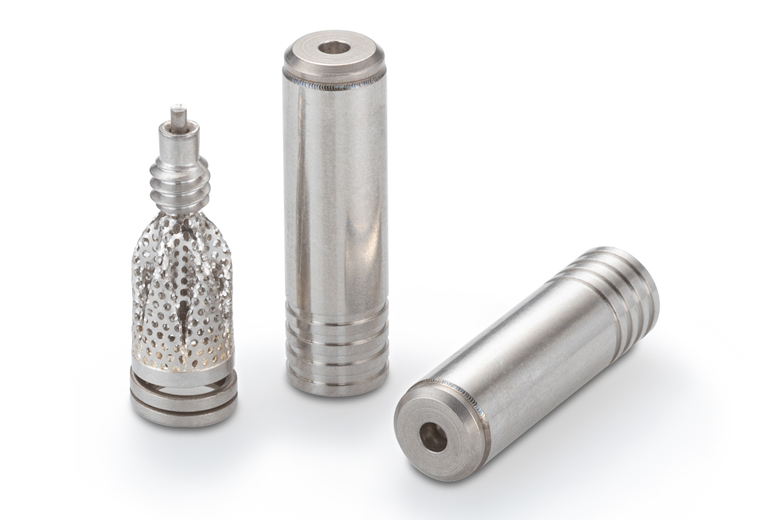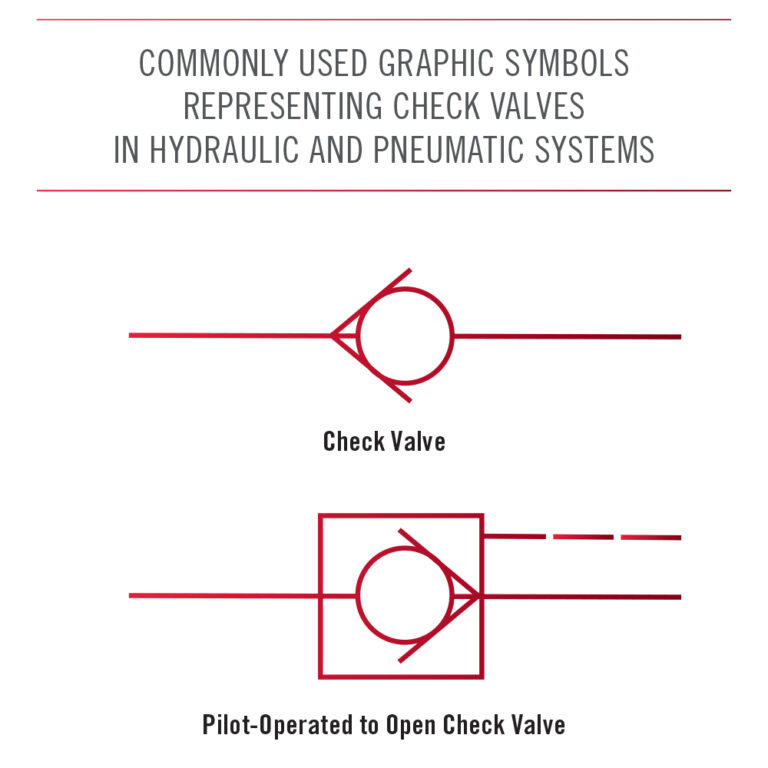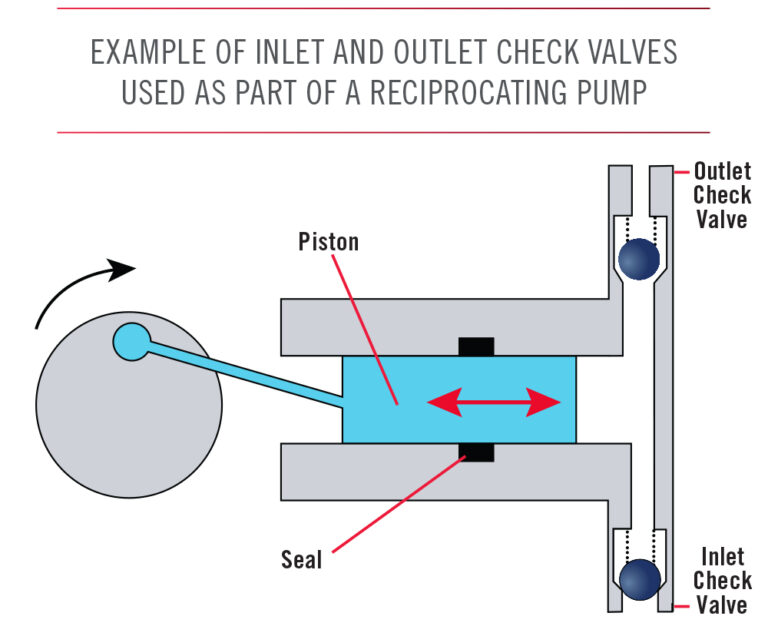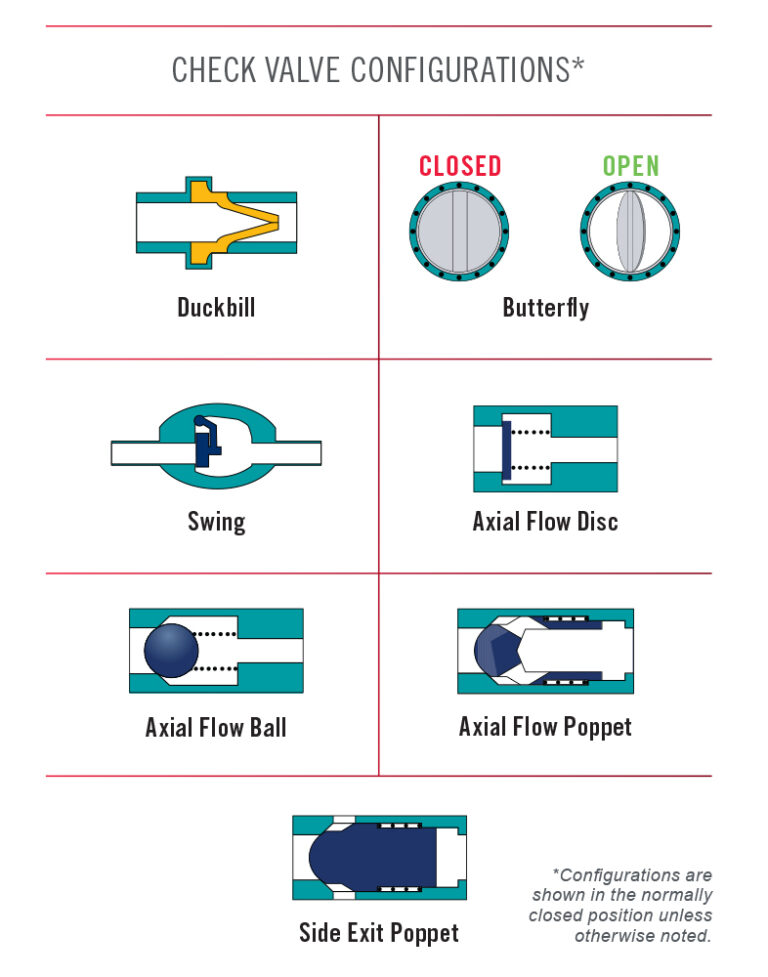
A check valve, a non-return or one-way valve, is a mechanical device that allows a gas or liquid to flow freely in one direction while preventing reverse flow in the opposite direction. The direction in which the fluid or gas can flow is called the free flow direction; the direction in which fluid is prevented from flowing is called the checked or non-return direction. Check valves are found in everyday household items. For example, when a raft or air mattress is inflated, the check valve allows air in and prevents escape until a release is activated. Irrigation systems also use check valves; they allow water to spray out of the sprinkler head and prevent mud and rainwater from flowing back into pipes leading to the water supply.

The purpose of a check valve in an application will determine some design parameters. Generally, check valve functions can be divided into three categories: non-return, vent, fill, and drain. Selecting the correct check valve ensures proper functionality during system operation.
These check valves allow flow in one direction with minimal pressure loss and prevent flow in the opposite direction. A typical application for a non-return check valve is in pump inlet and outlet ports. One check valve placed at the pump inlet allows fluid to flow from the desired source. A second check valve at the outlet allows the pump to dispense fluid.
Vent check valves are designed to open and prevent pressure build-up in a system while preventing flow in the checked, or non-return, direction. For example, vent check valves protect a vehicle’s fuel tank. Gasoline volume expands as it warms and contracts as it cools; the volume of gas in the tank fluctuates even when a car is parked. As the volume of gasoline increases, air must exit the tank to alleviate the change in pressure. The tank uses a check valve to vent air when pressure increases; this prevents damage within the tank and to connected components. The check valve also prevents debris and moisture from getting into the tank.
These check valves permit fluid to flow into a system and prevent the fluid from escaping once it is filled. Fill and drain valves are commonly found near the tank of any hydraulic or pneumatic system. If the system needs maintenance or will be retired, safety precautions may require depressurization of the charged system. The check valves used to fill the system may be piloted open, mechanically or manually, to drain the system fluid.

A check valve is a direct-acting device, meaning pressure acts directly upon the valve’s internal components. Check valves are typically normally closed components. They are often held closed by a force-producing mechanism within the valve. This force is minimal and returns the valve to a closed position when there is no longer a pressure differential acting on the valve in the flow direction. Some configurations have no force-producing mechanism; they require a pressure differential in both directions to move internal components. With a pressure differential in the flow direction, the valve opens and allows fluid to flow freely from one location to another within the fluidic system. When pressure is removed, the valve will return to its normally closed position.
Check valves are available in a variety of configurations. Standard configurations feature a ball bearing, poppet, disc, or other seal held against a seat when pressure is in the checked direction. In many cases, the seal will be biased into the position against the valve seat by a lightly loaded, compressed spring. The combination of these components creates the internal seal used to prevent flow in the checked direction. There are many configurations for the internal flow path of spring-loaded check valves. For example, the fluid may flow axially between the ball or poppet and the interior of the valve housing, or it may flow through passages within a poppet down through the center of the valve. Alternatively, some valve configurations allow flow to exit at 90 degrees relative to the valve inlet. In low-pressure applications, a check valve may utilize a flexible material to control flow based on pressure conditions. The material may act as a basic diaphragm or in a duckbill configuration. In high-flow hydraulic applications, butterfly and swing check valves are common. These valves use large, flat metal doors attached to a housing that causes them to open with the flow in one direction and shut in the checked direction.

Selecting and designing an ideal check valve requires detailed knowledge and striking balances between various performance requirements, environmental factors, and potential trade-offs. We understand that this can be a complex process. Consider downloading our Engineer’s Guide to Selecting a Check Valve for an in-depth walkthrough for more insights and guidance.
Moreover, if you have specific concerns or need tailored advice, do not hesitate to contact one of our Technical Sales Engineers. They are skilled and ready to provide the required guidance for your unique situation and assure that you make the most out of your check valve design and selection process. Remember, each check valve directly influences your system’s performance, making its careful selection a matter of great importance.
Always verify flow calculations by experiment.
*There are many parameters to consider when determining V-Factor. Click here for more information.